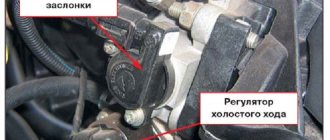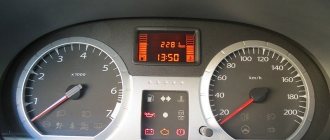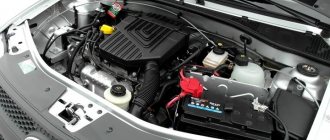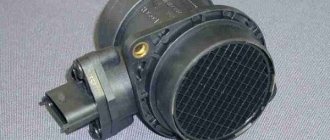According to reviews, the problem with floating engine speeds is familiar to many Lada Largus owners. This is especially true in winter, when the car has difficulty starting when cold (starting the engine is difficult in the morning). In such situations, floating speeds only make the situation worse. The tachometer needle may jump chaotically from 1000 to 1500 rpm or not reach the “warm-up” level at all, staying below the required idle speed values. Experts do not recommend self-diagnosis of the car. If the cause of the problem is unknown, it is better to contact a service station.
Lada Largus float revs
According to reviews, the problem with floating engine speeds is familiar to many Lada Largus owners. This is especially true in winter, when the car has difficulty starting when cold (starting the engine is difficult in the morning). In such situations, floating speeds only make the situation worse. The tachometer needle may jump chaotically from 1000 to 1500 rpm or not reach the “warm-up” level at all, staying below the required idle speed values. Experts do not recommend self-diagnosis of the car. If the cause of the problem is unknown, it is better to contact a service station.
Calibration
Since we remove the terminal from the battery for a long time, the ECU resets the calibration values of the XX regulator.
If calibration is not performed, the engine speed will fluctuate.
You can calibrate the sensor in 2 ways: using dealer equipment at a service station or manually. Let's take a closer look at the second option.
The vehicle's engine ECU updates the calibration positions of the XX sensor locking elements each time the power unit is started and when the vehicle reaches a speed of 50 km/h with uniform acceleration.
The calibration process consists of fully retracting the locking element and then releasing it until the valve is completely closed. Simply put, to calibrate the Renault Logan XX valve, it is enough to slowly accelerate to a speed of just over 50 km/h.
There is an alternative method in which you do not need to accelerate the car:
- Connect the negative terminal back to the battery.
- Turn on the ignition, wait 10-15 seconds without starting the engine. The regulator rod moves to its extreme position.
- We start the car. At this moment, the engine operates at high speed.
- We wait 1-1.5 minutes and turn off the engine. The XX regulator rod moves to its extreme position.
- Repeat steps 3 and 4 five times.
- We start the car again and let it idle for about 5 minutes. The XX speed will automatically reach the desired value.
What is pxx, its functions and operating principle
Before we begin to describe the malfunctions and the process for eliminating them, it is worth saying a few words about the idle air regulator.
The pxx sensor is installed in the throttle body. With its help, the ECU (electronic engine control unit) regulates the engine's idle speed. The idle air valve regulates the crankshaft speed by metering air flow through a bypass channel parallel to the throttle valve.
When the engine is warmed up to operating temperature, the computer supports the operation of the sensor. If the engine is cold, the ECU uses pulses to control the operation of the sensor and increases the speed to warm up. Gradually the speed decreases as it warms up.
The manufacturing plant equips vehicles with VDO sensors. When purchasing pxx for Renault Logan, you can purchase both a sensor in the original packaging and in VDO branded packaging. Both sensors are identical. The only difference is their cost.
Idle air regulator with cover 16V for VAZ Largus
The K4M engine is a gasoline, four-stroke, four-cylinder, in-line, sixteen-valve, with two overhead camshafts. The operating order of the cylinders is: 1–3–4–2, counting from the flywheel. Power supply system – distributed fuel injection (emission standards Euro 4).
When the K4M (16V) engine is idling (the throttle valve is closed), the electronic engine control unit (ECM) 8201264001 RENAULT controls the air supply using the idle air regulator IAC 8200692605.
Air from the air filter housing 1, having passed through the IAC 2, is supplied through a rubber hose 4 to pipe 5 of the oil separator housing and from there, through the air channel in the oil separator housing, enters the receiver 3.
Electronic idle speed regulator 8200692605 (IAC) Lada Largus is mounted on the air filter housing. IAC is a stepper motor with a micrometric screw (valve). The valve shut-off element (needle) changes the flow area of the channel and provides regulation of air flow bypassing the throttle valve.
To increase the crankshaft rotation speed at idle, the ECM sends a control signal to open the valve, increasing the air supply bypassing the throttle valve, and, conversely, to reduce the rotation speed, a command is sent to close the valve. When braking the engine, the throttle valve closes sharply, and the IAC increases the air supply bypassing the throttle valve, resulting in a leaner fuel mixture. This helps reduce emissions of hydrocarbons and carbon monoxide into the atmosphere.
The idle air control is non-separable and must be replaced if it fails.
Other article numbers of the product and its analogues in catalogues: 8200692605.
Lada Largus (4601), RENAULT Logan, Sandero, Duster.
How to independently replace the electronic idle speed control with a cover in a car of the Lada Largus K4M (16V) family.
With the online store Discounter AvtoAzbuka, repair costs will be minimal.
Just COMPARE and BE SURE!!!
Oxygen sensor for Lada Largus: original, analogues, price, catalog numbers
| Catalog article/marking | Price in rubles |
| Control 8200052063 (8 and 16 valves) | From 1600-1800 |
| Diagnostic 8201071311 (8 and 16 valves) | From 1600-1800 |
| NGK 95801 | From 1400-1500 |
| BOSCH 0 258 006537 | From 1400-1500 |
| ERA 570023 | From 1400-1500 |
| FENOX SD10100O7 | From 1400-1500 |
| BREMI 30223 | From 1400-1500 |
| DENSO DOX-0150 | From 1400-1500 |
| STELLOX 20-00028-SX | From 1400-1500 |
| PATRON HZ-30301006 | From 1400-1500 |
| *prices are as of May 2022 |
The lambda probe (LPS) monitors the oxygen content in the exhaust gases. The excess of air in the mixture is called “enrichment”, and the reverse process is called “depletion”.
Both factors negatively affect the functionality of the motor. This leads to decreased power, unstable idling, and increased fuel consumption.
In order to save money, many car owners purchase low-quality spare parts, which accelerates premature wear of the equipment.
Lada Largus (2019). The engine revs up slowly (causes and solutions)
Lada Largus (2019). The engine revs up slowly (causes and solutions)
When operating a gasoline or diesel engine, the driver may encounter the fact that when pressing the gas, the engine does not gain speed. Note that after installing LPG on a car, a problem often arises when the engine does not pick up speed on gas, although the car drives normally on gasoline. Malfunctions of various kinds can be hidden either in fairly simple things or indicate the need for serious repair of the internal combustion engine. Next, we will look at why a diesel engine does not pick up speed or a gasoline engine refuses to spin up.
If the engine has stopped gaining momentum, then the first thing you need to do is analyze when and how this manifested itself. In other words, the unit stopped spinning unexpectedly, or the problem with gaining speed gradually progressed. You should also pay attention to the presence or absence of other symptoms. The fact is that the failure of a previously serviceable engine to gain speed after any repairs or other manipulations may simply be the result of assembly errors, a not connected sensor, etc. In such cases, the malfunction can be quickly and accurately determined after an independent inspection or immediate return of the vehicle to the service center where the car was previously repaired. If you are faced with the fact that the engine stalls for no apparent reason, does not pick up speed, the car periodically stalls, etc., then in this case the engine needs in-depth diagnostics. The causes of such a breakdown can be divided into simple and complex, arising immediately or having received prerequisites. Why the engine does not gain momentum: from simple to complex
At the very beginning, let's look at simpler and more obvious faults. The set of revolutions while driving is greatly influenced by the efficiency of delivery, the timing of ignition and the completeness of combustion, as well as the composition of the fuel-air mixture. A common reason why an engine does not pick up speed (injector, carburetor, diesel, gas car) is problems in the ignition system, as well as in the air and fuel supply systems. Experts highlight the following: Severe contamination of the air filter reduces the ability of air to penetrate through the filter element, as a result of which engine operation becomes uneven, the unit loses power and does not gain speed. Another common cause of air supply problems may be that a foreign object (rag, plastic bag, etc.) may accidentally end up in the air filter housing. You should also pay attention to the leakage of excess air at the intake as a result of various defects in the intake system. The problem can appear unexpectedly or gradually progress. Note that the engine usually does not gain speed in case of strong air leaks. The fact is that in the composition of the fuel-air mixture, the normal ratio of air and fuel in such a situation noticeably deviates from the norm. The mixture turns out to be very “lean” (lots of air and minimal fuel). With such a charge, the engine starts, but does not gain speed while driving, and also runs intermittently. A similar picture can be observed when the required amount of fuel is not supplied to the unit. The culprit may be the fuel filter, which can also become severely clogged. Note that there may be no problems with starting the engine, since there is enough fuel for the XX mode. At the same time, while driving, the car may twitch, react to pressing the gas pedal with a long delay, dips may occur when the speed increases, or the unit may not spin above a certain mark on the tachometer. A dirty fuel pump mesh filter can also lead to similar symptoms. Deposits from the fuel tank tend to accumulate on this filter over time. As a result, the fuel pressure in the system becomes insufficient, the pump performance drops, and the engine itself is not able to operate normally in different modes. It often happens when the engine picks up speed and stalls precisely because the grid is clogged. Replacing the fuel pump mesh. We also recommend reading the article on how to clean or replace the fuel pump mesh yourself. From this article you will learn about the installation location of this fuel pump grid, as well as the available methods for cleaning it yourself. If the spark plugs or high voltage wires are not working properly, then the mixture may not ignite properly. As a result, ignition of the fuel charge in the cylinder may occur untimely, engine power drops, and speed does not increase. Such consequences are caused by oiling or contamination of spark plugs (especially on internal combustion engines with a significant mileage), damage to the spark plug body, and incorrectly set gaps on the electrodes. Also, the appearance of a spark and its quality can be directly affected by the breakdown of high-voltage spark plug wires, as well as their breaks. In such cases, the engine begins to stall, misfires and misfires are observed, and the speed gain deteriorates. The driver can identify most of the above reasons and fix them relatively cheaply on his own. It is necessary to check the spark plugs and wires of the ignition system for a spark, measure the pressure in the fuel rail on fuel-injection internal combustion engines, inspect the air filter for contamination, replace the fuel filter, clean the fuel pump mesh, etc. Now let's talk about problems that may require certain knowledge, skills and equipment for diagnosis, and also be a reason for a visit to a car service center. Let's start with the fact that this list of faults usually includes those when the engine does not gain speed due to the failure of any element of the ECM, ignition system, power supply, etc. In other words, we are no longer talking about “consumables” (spark plugs, wires, filters, pipes), but about details. In parallel with this, one should also take into account whether the breakdown occurred unexpectedly or whether the fault progressed gradually. One of the reasons may be misaligned timing. Violations of the synchronous operation of the gas distribution mechanism regarding the intake and exhaust strokes lead to the fact that the intake and exhaust valves open untimely. The malfunction occurs as a result of errors during timing belt replacement if said timing belt has jumped one tooth or more teeth. Also, the cause may be incorrectly adjusted valves (the problem does not manifest itself sharply), various problems in variable valve timing systems, breakdown of the timing chain drive, etc. Unexpected breakdowns include failure of the ignition module, as well as malfunctions of the ignition coils. In this case, the cylinders begin to misfire, the engine stalls and loses the ability to gain speed normally. In situations with engine speed, the power supply to the injection nozzles should be checked. If problems arise with the wiring, then the control signal is not supplied to the injector or is received intermittently. As a result, the injector does not open in a timely manner, misfires occur in one or more cylinders, the engine does not reach the required speed and loses power. The fuel pump or fuel injection pump on diesel engines may fail. This problem usually does not occur immediately (except in cases where the electrical wiring to the pump is damaged). Much more often, the decrease in pump performance occurs gradually. Sooner or later, the pump will begin to pump fuel very weakly; the pressure will only be enough to operate in idle mode. An increase in load and speed will lead to the engine stalling under load, not spinning up, etc. In some cases, severe contamination of the injector itself leads to similar results. Driving on low-quality fuel, as well as ignoring the necessary procedure for cleaning injectors every 30-40 thousand kilometers driven, can mean that the performance of one or more fuel injectors has dropped significantly. Engine speed can also be affected by the condition of the EGR system, the throughput of the catalyst or particulate filter. As for the second case, due to a clogged catalyst, exhaust gas removal deteriorates, the engine literally “suffocates” and is not able to gain normal speed. At the same time, it is necessary to check various sensors of the electronic engine management system. Their incorrect operation can affect the composition of the mixture, that is, the amount of fuel and air supplied to the internal combustion engine. Such sensors include TPS, DMRV and a number of others.
Eventually
Considering that there are many reasons for problems with revving on a modern car, it is optimal to immediately connect the car to diagnostic equipment (scanner) to search for possible errors. This is especially necessary to do in the case when the engine does not pick up speed and the check light on the dashboard lights up. Note that a fairly rare, but also possible, case is the failure of the ECU. This often happens after washing the engine, as well as as a result of unprofessional interventions in the factory firmware of the controller. A sign of problems with the electronic unit is that the engine picks up speed but loses speed. Such failures are associated with a software malfunction in the operation of the electronic device. The ECU mistakenly takes low speeds (for example, 2-3 thousand rpm) for the so-called “cut-off” speed and stops the fuel supply. In other words, the conditional protection against exceeding the permissible maximum engine speed is triggered prematurely. Finally, I would like to add that timely cleaning of the injector, replacing spark plugs and ignition wires, filters and fuel pump filter elements, cleaning the throttle valve, correct throttle adjustment and a number of other service procedures will allow you to get maximum power from your internal combustion engine. As for cars with gas equipment, not only the engine power and its speed on gas, but also the overall service life of the power unit will depend on the correct installation and configuration, as well as on the timely replacement of filters and maintenance of other elements of gas equipment.
Air leaks as a cause of floating speed
Many owners note that in the mornings, especially in winter, the engine is unstable after starting, the speed jumps, and the car begins to twitch while driving. They look for a problem in the immobilizer or spark plugs, but if the diagnostics do not reveal any problems, the problem is in the throttle assembly.
The malfunction consists of air leaking through a loose connection between the throttle assembly and the intake receiver. The problem is solved either by replacing the sealing ring with a similar new one, or by modifying the design using plumbing tape. Procedure for replacing the ring:
Next, everything is assembled in reverse order and tested for functionality.
Although the engines were borrowed from popular Renault models, they migrated under the hood of the VAZ Largus along with common faults. However, the problem with floating idle speed can be eliminated on your own. If you lack confidence and experience, it is better to contact a service station.
The cause of a stalled engine is a power supply failure
In this type of problem, 3 reasons may be involved:
- Poor contact with the terminals of the new battery;
- Detection of poor contact or breakdown along the entire length of high-voltage wires;
- The appearance of malfunctions in the generator or ignition coil system of the car.
If the problem lies in damp high-voltage wires, then it is best to replace them completely along with the battery contacts. If the terminals make poor contact, you need to carefully clean them with sandpaper and try to reconnect them. If the generator is found to be inoperable, the problem usually boils down to problems in the following parts:
- Broken timing belt;
- There is a malfunction inside the housing of the unit itself.
A problem with the generator is easily detected when the corresponding indicator on the dashboard turns on. In addition, if there is insufficient energy supply, the backlight of the on-board panel will gradually fade, and a set of other diagnostic sensors will show incorrect values.
From the list of reasons that are directly related to the car engine, you need to move on to problems that arise in the fuel and air supply systems, as well as malfunctions of components responsible for exhaust gas removal.
Ignition coil
timing belt
Symptoms and triggers
At idle, the engine operates with light loads at a speed of 700-900 rpm, consuming minimal fuel. This well-regulated mode is necessary in various situations. It is ideal for warming up the engine, parking in traffic jams, and heating the interior in a parking lot.
Unstable operation of the engine at idle appears in the event of various malfunctions.
With constant pressure on the accelerator pedal, the rev surges are eliminated, so the engine runs smoothly while driving on the highway. In quieter driving modes the problems become more severe.
Unregulated idle speed
The idle air regulator may fail due to a violation of the integrity of the wires due to poor fuel.
This device controls blow-by gases that enrich the air-fuel mixture inside the intake manifold.
If this process is disrupted, then the engine speed drops from 1200 to 750 in 1 minute. In addition, the ventilation valve may jam due to the formation of oil deposits on the crankcase walls.
Dirty jets
The reason for the air-fuel mixture becoming too rich may be a nozzle clogged with dirt. This leads to a decrease in idle speed. In the case of a carburetor engine, it is necessary to adjust the fuel level and check the floats.
Piston and ring wear
In such situations, compression is lost, since the tightness of the cylinder block is often broken.
Wear of piston rings and gaskets leads to oil leaks, traces of which are visually visible on the base of the engine. This may cause interruptions when starting the car and disruption of engine stability.
Failure of the carburetor solenoid valve
If the engine stalls when coasting or idling, or pronounced detonation appears after the ignition is turned off, then these are clear signs of a malfunction of the EM carburetor. In addition, in such situations, instability of the running engine appears when an additional load is turned on.
Spent spark plugs
For stable engine operation, a stable spark is required, which ignites the mixture of air and fuel. These processes are ensured by the ignition system, which consists of spark plugs, an ignition coil, and high-voltage electrical wires. Glow plugs are used to ignite diesel fuel.
Depending on the design and material of the central electrode, spark plugs have different lifespans. As wear occurs and carbon deposits appear, a “wandering spark” effect may occur, which disrupts the stability of idle speed and makes it difficult to start the engine. Idle stability is affected by the condition of the spark plugs, wires, and ignition coil.
Fuel supply faults
It is quite easy to find out that the car stalls while driving due to the engine being “choked” with the fuel mixture - during a long drive you will find that the signal of the sensor responsible for this function is constantly on.
Here the problem lies in low-quality fuel, which does not quickly “ignite” from the spark of the candles. It can also be caused by gasoline not meeting the requirements for the octane number specified in the vehicle specifications. If there are problems with fuel, the gas pedal will be pressed all the way, and the car will not begin to gain speed. In addition, the car will periodically stall when the clutch is engaged.
Another symptom indicating problems with fuel is the appearance of problems with the car after refueling. The problem is characterized by a rapid drop in engine power at full speed, as well as when constantly changing gears. The way out of the situation is to completely drain the bad fuel mixture, wash the engine and all the fuel system pipes.
- Dirt in the fuel filter;
- Problems with injector nozzles;
- Dirty throttle valves;
- Fuel pump power failure.
The main symptom of a malfunction of these parts is that there will be a gradual drop in the power of the car’s engine, after which the car will stall even after sharply pressing the gas pedal. If you do not release the clutch carefully when changing gears, this will also cause the engine to stall.
The contamination of the fuel filter and fuel pump can be judged by the unstable operation of the machine even during idling and during rapid braking (when the supply of the fuel mixture decreases). And if the performance of fuel filters can be easily established during an external inspection and eliminated by replacing them, then to detect other causes, you need a full-fledged computer diagnostics, which can only be carried out in a car service center.
Another reason for a stalled car associated with the operation of the fuel pump is boiling gasoline in the fuel pump. This happens mainly in hot weather when the car is moving slowly or standing on the highway in traffic jams. The car will start to stall while driving, but when you turn on the idle speed and press the clutch, it will start again.
If boiling occurs, it is better to stand in a traffic jam with the engine turned off and gradually cool the car. After 5-10 minutes, the car's operation will be stable again.
Engine speed fluctuates: symptoms and main causes
First of all, the tachometer helps to notice floating speed. Most often, the floating speed appears at idle. Normally, even on a slightly warmed-up engine, the tachometer needle should remain stable at about 800 rpm while idling.
The only exception is the warm-up speed XX, when the ECU on injection engines itself raises the speed to 1000-1100 rpm. In this case, after the engine temperature rises slightly, the control unit will lower the idle speed to the desired level of 750-800 rpm.
Also, jumps in speed can be observed if you increase the load on the engine (press the brake pedal, turn the steering wheel in a car with hydraulic booster, turn on the air conditioning or climate control, etc.). The revolutions may also fluctuate while driving in transition modes.
In this case, without additional load, the engine can keep the speed stable at idle, but as soon as the load appears, the speed drops, and the engine almost or completely stalls.
The driver may also notice a significant increase in fuel consumption, the engine response changes when exiting transient modes, jerks and dips may occur during acceleration, etc.
Which engines are better? VAZ or Renault?
Domestic engines are superior to their French predecessors. Cars with VAZ engines accelerate faster, pull better at low speeds, are quieter and have lower fuel consumption.
Both domestic engines installed on the Lada Largus are modifications of older models. They have already stood the test of time and proven their competitiveness. Thanks to the reduction in the cost of engines, AvtoVAZ added to the car's equipment - athermal glass was added, an improved vacuum brake booster, the windshield wiper mechanism was changed, additional sensors appeared, etc. The car became more comfortable, but the price remained the same.
VAZ 11189 and 21129 have an important advantage. Spare parts for them are cheaper than for French engines
All internal combustion engines installed on Largus require careful maintenance and monitoring, but driving a car with a domestic engine is cheaper.
To make the price of spare parts and service even cheaper, order them from Largus Shop with free delivery. We regularly hold promotions and give discounts to regular customers.
How to eliminate floating idle speed on Lada Largus
One of the shortcomings that was noticed by owners of Lada Largus cars is floating speed after starting the engine in the morning. A long search for the cause of the unstable operation of the power unit led to the throttle assembly. It turns out that the whole problem lies in air leaks through the connections of the intake receiver and the remote control.
To troubleshoot the problem we will need:
Instructions for eliminating floating speed on Lada Largus
Disconnect the idle air passage hose
Now you need to use a TORX key to unscrew the 2 screws with which the intake receiver is attached to the remote control and pull it a little to the side, since you will not be able to remove it due to the heater hoses.
Read more about do-it-yourself VAZ car repairs
The idea to eliminate floating speed on the Lada Lagrus belongs to Pavel Luzin
Source
About the domestic VAZ 11189 engine
In April 2022, AvtoVAZ began installing domestic VAZ 11189 engines on Largus. The advantages of this engine are described in one of the issues of “Okay Mechanics”.
| Some measurement results Autoreview | |||
| Options | Cars | ||
| Lada Largus (VAZ engine) | Lada Largus (Renault engine) | ||
| Maximum speed, km/h | 157,1/156,7* | 168,0/167,6 | |
| Acceleration time, s | 0—50 km/h | 4,3/4,8 | 3,9/4,4 |
| 0—100 km/h | 13,9/16,8 | 12,5/14,5 | |
| 0—150 km/h | 61,1/71,6 | 38,9/43,7 | |
| on the way 400 m | 19,3/20,2 | 18,4/19,4 | |
| on the way 1000 m | 36,1/37,8 | 34,1/36,0 | |
| 60-100 km/h (III) | 8,7/10,6 | 9,3/10,6 | |
| 60-100 km/h (IV) | 12,1/15,1 | 12,8/14,1 | |
| 80-120 km/h (V) | 19,3/24,0 | 22,1/23,4 | |
| * Partial load/full load | |||
| Engine characteristics | ||
| Options | VAZ-11189 | Renault K4M |
| Volume, cm 3 | 1596 | 1598 |
| Number of valves | 8 | 16 |
| Maximum power, hp/kW/rpm | 87/64/5100 | 102/75/5750 |
| Maximum torque, Nm/rpm | 140/3800 | 145/3750 |
| Cylinder diameter/piston stroke, mm | 82,0/ 75,6 | 79,5/80,5 |
| Compression ratio | 10,3:1 | 9,8:1 |
| Injection type | distributed, electronically controlled | |
| Octane number of gasoline | at least 92 | not less than 95 |
Let us remind you that you can read about the VAZ 21129 engine here.
Key words: Lada Largus engine
AvtoVAZ several years ago set out to create a good car. A kind of workhorse for the people. Even then, the work of the VAZ-Renault alliance was in full swing. Largus is a direct reflection of teamwork. They developed a car based on Logan. The platform is so successful that the Duster crossover, Sandero hatchback and many Nissan car models are produced on it.
Engine speed fluctuates on Largus - solution
Many Lada Largus car owners, judging by numerous reviews on the Internet, have a problem with floating engine speeds. This becomes especially noticeable in cold weather during startup. The revolutions can jump from 1000 to 1500 and return to normal only after the engine has completely warmed up.
Some tried to change the spark plugs, the fault was with the sensors, including the idle air control, but for the majority the problem remained unresolved. Moreover, in fact, it was hidden in a simpler form than many imagined. After numerous experiences of Largus owners, we can safely say that the main reason for the floating speed was air leakage through loose pipes at the throttle assembly.
The solution was quite simple, it was enough to buy a new ring that matched the throttle in diameter. And then everything according to the instructions:
Below everything will be presented in the photo gallery:
Installation occurs in reverse order. As for the price of this rubber band, or ring, call it what you want - it is about 300 rubles for the original. And that is why the owners of Logans and Largus are trying to find an analogue, which usually does not exceed 20 rubles apiece.
Independent search for the cause
What to pay attention to:
- Check the MAF (mass air flow sensor).
- Examine the IAC.
- Examine the wiring of the DS (speed sensor).
- DPKV (crankshaft position sensor) is the next object of inspection. But the reason, most likely, is not in it specifically, but in its chip or wiring.
- The TPS (throttle position sensor), an element of the throttle assembly, must also undergo a thorough inspection in such a situation. Perhaps a simple cleaning is needed.
- Check high voltage wires and spark plugs.
Once the cause is identified, the problem must be corrected. Your actions in this case depend entirely on what exactly went wrong.
How to eliminate floating idle speed on Lada Largus
One of the shortcomings that was noticed by owners of Lada Largus cars is floating speed after starting the engine in the morning. A long search for the cause of the unstable operation of the power unit led to the throttle assembly. It turns out that the whole problem lies in air leaks through the connections of the intake receiver and the remote control.
To troubleshoot the problem we will need:
Instructions for eliminating floating speed on Lada Largus
On the intake receiver we remove the wire and fasteners that go to the throttle assembly.
Disconnect the idle air passage hose
Now you need to use a TORX key to unscrew the 2 screws with which the intake receiver is attached to the remote control and pull it a little to the side, since you will not be able to remove it due to the heater hoses.
The idea to eliminate floating speed on the Lada Lagrus belongs to Pavel Luzin
Car engine modifications and their features
The reasons why the speed may fluctuate on Largus are due to differences in the technical characteristics of the engines. Depending on the configuration, an 8- or 16-valve engine is installed.
Return to contents
8-valve K7M 800
This engine model was borrowed from Renault Logan and Sandero. Such motors have been installed on Largus since 2010. The unit complies with the Euro-4 standard, its power is 83 hp. With. Among the disadvantages:
- floating idle speed;
- high fuel consumption;
- lack of hydraulic compensators in the valve mechanism - the gaps need to be adjusted every 30,000 km;
- the need to replace the timing belt every 60,000 km - a broken belt will inevitably lead to bending of the valves;
- unreliability of crankshaft oil seals;
- vibration and increased noise during operation of the power unit.
The 8-valve engine is too weak for Largus. Among the advantages are the unpretentiousness of the engine and its inexpensive maintenance.
Return to contents
16-valve K4M
This engine is used only in the top modifications of Largus in the “Lux” configuration. Engine power is 106 hp. s, but it still requires improvements. It differs from the previous unit:
- absence of vibration and almost complete absence of noise;
- low fuel consumption.
The disadvantage of the 16-valve engine can be considered its complex design, which leads to the high cost of the car. The engine life is about 450,000 km, but servicing the unit is more expensive. The main thing is not to use it often under increased loads and undergo maintenance on time.
Return to contents
This is interesting: Removing the rear support of the Lada Granta power unit
The speed fluctuates, the engine stalls at idle or when driving
Have you encountered engine problems when the car stalls in traffic jams or the engine speed is unstable? There may be several reasons for these malfunctions. It is recommended to start searching for a problem with diagnostics, and if this is not possible, then first perform a check, and only then change the faulty parts.
AvtoVAZ installs the same type of engines on modern Lada cars (Kalina, Granta, Priora, Largus, Vesta, Niva or XRAY), so the solution to problems for all these cars is similar.
The idle speed fluctuates, the engine stalls when moving (on the move) or at a standstill, the reasons may be the following:
Have you encountered floating engine speeds? What was the cause of the malfunction? We solve such engine problems in the comments or on the forum. Let us remind you that along with unstable speed there may be other problems, for example, the engine is difficult to start.
Causes and methods of eliminating difficult engine starting
To successfully start the engine, the fuel mixture and a spark from the spark plugs must simultaneously appear in its cylinders.
The engine cannot be started if one or more elements are faulty. This happens, for example, when the starter does not spin the crankshaft.
If floating idle speeds have become too annoying, and it is no longer useful to turn the engine with the starter, it’s time to understand the causes of the malfunctions that have arisen. The table shows the most common reasons why the Lada Largus engine speed fluctuates and it may not start.
Remedy
Regular and timely maintenance of the car will minimize or completely eliminate possible problems with starting the Lada Largus engine.
You should not randomly change all the parts without first checking their functionality. Comprehensive diagnostics are necessary, since there can be several sources of malfunction at once. Modern cars of the VAZ family are equipped with the same type of engines. For this reason, the solution to the problem will be virtually the same for different cars.
This is interesting: Removing and installing the hydraulic clutch pipeline Lada Largus
Why do the revs fluctuate on the Lada Largus?
According to reviews, the problem with floating engine speeds is familiar to many Lada Largus owners. This is especially true in winter, when the car has difficulty starting when cold (starting the engine is difficult in the morning). In such situations, floating speeds only make the situation worse. The tachometer needle may jump chaotically from 1000 to 1500 rpm or not reach the “warm-up” level at all, staying below the required idle speed values. Experts do not recommend self-diagnosis of the car. If the cause of the problem is unknown, it is better to contact a service station.
Car engine modifications and their features
The reasons why the speed may fluctuate on Largus are due to differences in the technical characteristics of the engines. Depending on the configuration, an 8- or 16-valve engine is installed.
8-valve K7M 800
This engine model was borrowed from Renault Logan and Sandero. Such motors have been installed on Largus since 2010. The unit complies with the Euro-4 standard, its power is 83 hp. With. Among the disadvantages:
The 8-valve engine is too weak for Largus. Among the advantages are the unpretentiousness of the engine and its inexpensive maintenance.
16-valve K4M
This engine is used only in the top modifications of Largus in the “Lux” configuration. Engine power is 106 hp. s, but it still requires improvements. It differs from the previous unit:
The disadvantage of the 16-valve engine can be considered its complex design, which leads to the high cost of the car. The engine life is about 450,000 km, but servicing the unit is more expensive. The main thing is not to use it often under increased loads and undergo maintenance on time.
Causes and methods of eliminating difficult engine starting
To successfully start the engine, the fuel mixture and a spark from the spark plugs must simultaneously appear in its cylinders.
The engine cannot be started if one or more elements are faulty. This happens, for example, when the starter does not spin the crankshaft.
If floating idle speeds have become too annoying, and it is no longer useful to turn the engine with the starter, it’s time to understand the causes of the malfunctions that have arisen. The table shows the most common reasons why the Lada Largus engine speed fluctuates and it may not start.
Remedy
Regular and timely maintenance of the car will minimize or completely eliminate possible problems with starting the Lada Largus engine.
You should not randomly change all the parts without first checking their functionality. Comprehensive diagnostics are necessary, since there can be several sources of malfunction at once. Modern cars of the VAZ family are equipped with the same type of engines. For this reason, the solution to the problem will be virtually the same for different cars.
Air leaks as a cause of floating speed
Many owners note that in the mornings, especially in winter, the engine is unstable after starting, the speed jumps, and the car begins to twitch while driving. They look for a problem in the immobilizer or spark plugs, but if the diagnostics do not reveal any problems, the problem is in the throttle assembly.
The malfunction consists of air leaking through a loose connection between the throttle assembly and the intake receiver. The problem is solved either by replacing the sealing ring with a similar new one, or by modifying the design using plumbing tape. Procedure for replacing the ring:
Next, everything is assembled in reverse order and tested for functionality.
The process of replacing the throttle assembly O-ring takes a maximum of half an hour.
Although the engines were borrowed from popular Renault models, they migrated under the hood of the VAZ Largus along with common faults. However, the problem with floating idle speed can be eliminated on your own. If you lack confidence and experience, it is better to contact a service station.
Technical characteristics of Lada Largus depending on the number of internal combustion engine valves
To get closer to the specifics, let's look at the technical characteristics of the Lada Largus declared by AvtoVAZ using the example of a specific model, depending on the choice of power unit (five-seat station wagon). Perhaps the motorist will also be interested in how the Largus engine with 8 and 16 valves is fundamentally different, which we will discuss in the next section of the article. As for the topic that concerns us, depending on which engine is installed in the Lada Largus, the following defining parameters of the car change:
- fuel consumption in a particular operating cycle;
- dynamic driving characteristics;
- torque that the engine can develop.
Naturally, the 8-valve engine in Largus will be considered less advanced, having slightly lower efficiency. Hence, higher fuel consumption is expected. However, the engineers who developed the heart of our iron horse managed to reduce this difference to an insignificant figure. The difference between the two power units is only 0.5 L per 100 km. in the urban driving cycle (10.6 liters versus 10.1). In the suburban operating cycle, the difference in fuel consumption practically approaches zero.
Differences in the dynamic performance of the Lada Largus are also noticeable. This applies, in particular, to the time it takes a car to accelerate to 100 km and maximum speed. The 8-valve engine, due to its lower power, will stop at 156 km/h, and the 16-valve engine is capable of accelerating the Largus to a speed of 165 km/h.
All of the above are perhaps minor details. The difference in the dynamic characteristics of the Lada Largus is already more noticeable when it comes to acceleration speed. 14.5 seconds versus 13.1. And this, in turn, is already determined by the lower torque. Otherwise, including reliability and fuel type, both power units are no different.
Unstable idle on Lada Largus
Owners of Lada Largus often complain about unstable idling of a cold engine. The problem appears especially often during the cold season. But over time, the idle speed begins to float even in the summer on a cold engine.
There are only 3 main reasons for unstable idle speed on the Lada Largus:
In all 3 cases, an experienced technician will solve the problem in 30-60 minutes. This time is enough to remove carbon deposits, assess the condition of parts and seals, and check the operation of the engine after repair.
Carbon deposits on the idle air valve or throttle body and walls
Carbon deposits appear due to low-quality fuel, an old air filter, worn cylinders or a faulty crankcase ventilation system. In most cases, the problem is due to poor quality fuel.
If unstable idling is caused by carbon deposits, then simply cleaning the valve or throttle body is enough. Sometimes you can remove dirt without removing parts. But it’s better to remove the spare parts from the car - this way it’s easier to clean them and you can make sure there are no defects. It also becomes possible to assess the condition of the O-rings.
Damage to throttle valve O-rings
2 o-rings are responsible for the tightness of the throttle valve connection. One of them is located on the intake manifold side, the second on the air filter side.
Over time, the rubber rings dry out. The material loses volume and shape. Because of this, the system becomes leaky and air begins to enter it.
Idle speed can only be affected by the seal located on the intake manifold side. If the ring has dried out and lost volume, the revolutions will float. The second seal does not affect idle speed, but it also needs to be checked.
You can make the system sealed again in different ways:
We do not recommend installing non-original seals. Except when you are confident in the quality of the materials and the manufacturer.
Floating idle speed can be explained by other reasons. Therefore, it is better to entrust the repair to a specialist. He will check the condition of the car and make sure there are no other faults.
Lada Largus 7 seats equipment 02D › Logbook › The engine speed floats, we treat it like everyone else
The revs began to fluctuate a little when cold, and they stayed for a long time at 1300 rpm when warming up; in general, Largus’s favorite problem with the K4M began to appear.
This is my second Largus, on the first I wound up the fum tape, then under warranty they changed the receiver, installed a new one with the inscription RENAULT, but the rings are of course a weak point. So, the known methods of treatment 1.) Rewind the fum tape, not reliably, not for long, the fum tape practically does not absorb shock, as a result, the ring presses its place in it and the suction appears again. 2.) Put a new ring with a code 8200068566
, good but expensive, the toad is against it and there is a chance that the ring will last for a year.
3.) Put on a Nisanov ring with code 16618-00QAA
, this is the same new ring only with a different code and a lower price, but still the toad is against it.
4.) Install the Gostov ring GOST 18829-73/9833-73 064-072-46
, cheap, reliable and cheerful, but mother is lazy, you need to look for such rings. 5.) There were Gost rings available, but not 4.6 but 6 mm, so I decided to make myself an eternal ring from it, because... the ring is thicker, the throttle with such a ring doesn’t fit into the receiver, so I’m redoing it a little. I just file off the excess rubber and it becomes a little flat. We assemble this device from a canister cap, a bolt with a nut and two washers, a drill and a file clamped in a vice.











